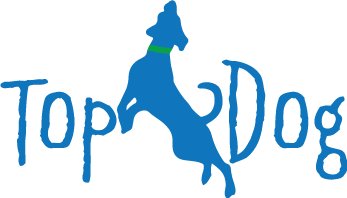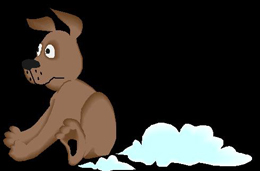In my 10 years of working with dogs, anal glands have become, sort of, a normal topic of conversation for me. While I still find it disgusting, it’s not as terribly repulsive as it used to be. And as common a topic as it is for me, I’m finding some dog owners don’t even know what the anal glands are! So . . . I’m going to dish out the dirt . . . literally, because it’s kind of gross.
A dog’s anal glands, also known as anal sacs, are basically scent glands. They are located on each side of the dog’s rectum. The sacs are lined with sebaceous glands that produce a very foul smelling substance. The pheromones secreted give other canines important info about your dog, like his age, sex, and overall health. Yes . . . this is why dogs sniff each other’s rear ends when first meeting. This is also why your dog insists on smelling every pile of mystery poop along your daily walks. Every time a dog with healthy anal glands has a bowel movement, the glands are expressed naturally. The firm stool pushes against the glands as it exits the rectum, squeezing the substance from the glands onto the poo. Gross, I know, but bear with me!
The problem with anal glands comes in when they don’t, or can’t, empty properly on their own. Unhealthy anal glands are more commonly found in smaller breeds and obese dogs, typically due to malformations or an unhealthy diet. When the glands don’t empty on their own, they can become impacted, leading to infection, abscesses and difficulty with bowel movements. Common signs that your dog may be having troubles with their anal glands are quite obvious . . . scooting their butt on the ground (or your carpet!), licking or biting at their rump, or a foul, fishy smell coming from their back side. If you notice these classic signs, it’s best to have your vet take a look.
A veterinarian can do a rectal exam to check and see if the glands are full. If they feel they need to be manually expressed, they can do it quite easily by lightly squeezing each gland. It’s not pretty, and it definitely doesn’t smell good, but having your vet or vet tech express the glands is the best way to ensure it’s done properly, and without too much force.
Almost all groomers will express a dogs anal glands during the grooming process. This is where, I think, a lot of the “problems” come in. Any groomer I’ve met (including myself) only expresses anal glands externally. We know that the anal sacs are located at 4 and 8 o’clock on the dog’s anus. Using the thumb and pointer finger, you gently push in and upwards on the round sacs that typically can be felt externally. You continue this motion if secretion is coming out. If the groomer is pressing too hard, they could be doing more harm than good. When anal glands are recurrently expressed, they lose muscle tone, and over time, become incapable of expressing naturally. Rather than repeatedly manually expressing, perhaps we need to look at why the dog is needing the glands expressed so frequently. Three main reasons for anal gland problems are trauma, location and diet.
We’ve already discussed trauma. If the sacs are repeatedly being manually expressed, they’re going to lose muscle tone and become dependent on manual expression. It might be a good idea to request that your groomer does not express the anal glands, and leave the dirty job to the medical team.
Some dogs, for unknown reasons, have anal sacs that are located very deep inside their rectums. As stool collects in the colon, the pressure as it passes through should cause the glands to empty. However, if glands aren’t near to where the greatest amount of pressure builds in the large intestine, they can’t express properly. There is a surgery option, to have the glands removed completely, but make sure to discuss the pros and cons with your vet before jumping to this conclusion.
Lastly, and most importantly, is diet. The only way the glands can express naturally, is if the stool passing by is firm enough to push the secretions out. If your dog has consistent loose, unformed stool, it’s not applying the needed pressure to express. Feeding a higher quality diet and maintaining a healthy weight will help keep your pet’s rear end happy. Overweight dogs have insufficient muscle tone and extra fatty tissue back there, which doesn’t allow the stool to get up close and personal with the glands on its way out. Switch your pet to a high quality, grain free food. The less processed, the better. Dogs in nature eat raw meat, bones, sticks, berries and dirt, which is why we will always tell you a raw diet is the best thing for your dog. Adding a probiotic or digestive enzyme is a great idea to help keep stools firm and regular as well.


